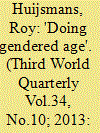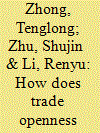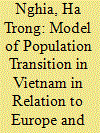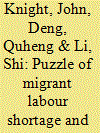|
|
|
Sort Order |
|
|
|
Items / Page
|
|
|
|
|
|
|
| Srl | Item |
| 1 |
ID:
093010


|
|
|
| 2 |
ID:
074182


|
|
|
|
|
| Publication |
2006.
|
| Summary/Abstract |
Demographic transition has occurred more rapidly in China than in most developed countries. As the population ages, the growth rate of the working age population has started to decline and the absolute quantity of the working age population will begin to shrink after 2015, which will inevitably result in structural labor shortage. Under the circumstance where comparative advantage is still embodied in its labor-intensive commodities, timely and sufficient supply of a skilled labor force is vital for China to sustain fast economic growth.
|
|
|
|
|
|
|
|
|
|
|
|
|
|
|
|
| 3 |
ID:
069629


|
|
|
|
|
| Publication |
Santa Monica, Rand Corporation, 2003.
|
| Description |
xv, 106p.
|
| Standard Number |
0833029266
|
|
|
|
|
|
|
|
|
|
|
|
Copies: C:1/I:0,R:0,Q:0
Circulation
| Accession# | Call# | Current Location | Status | Policy | Location |
| 046556 | 304.62/BLO 046556 | Main | On Shelf | General | |
|
|
|
|
| 4 |
ID:
126108


|
|
|
|
|
| Publication |
2013.
|
| Summary/Abstract |
In this article I analyse the reconfiguration of the intersection of relations of gender and age manifesting between older mothers and their migrant daughters. For this I study the negotiation of care work between differently positioned women, drawing on material from Lao PDR and Thailand. Theoretically I draw on the constructivist notion of 'doing gendered age', which allows us to integrate the performance of gender-age subject positions with structural changes, most notably the generational dynamics of rural transformation, an expanding neoliberal labour market and demographic transition. I conclude that gender-age subject positions hold women accountable for 'doing gendered age' in a particular manner. This forms an important basis for informal mechanisms of social protection. However, these subject positions are neither pre-given nor voluntary but are enacted through everyday social interaction and subject to change.
|
|
|
|
|
|
|
|
|
|
|
|
|
|
|
|
| 5 |
ID:
177693


|
|
|
|
|
| Summary/Abstract |
This study aims to document the age structure and mortality by age in the Ottoman city of Bursa that served as a politically and commercially significant urban center over centuries. It uses a set of hitherto unexamined Ottoman population registers kept in 1839 and updated until 1842 that provide detailed self-reported data on all male inhabitants regardless of age, including deaths, births, and migration. The study tests the quality of age and mortality data in conjunction with the Coale and Demeny regional model life tables and compares the results to historical demographic studies conducted for European regions. The results point to a demographic structure marked by high birth and death rates and prove promising for extending back the study of Ottoman demographic transition and establishing historical comparison points with the global experience.
|
|
|
|
|
|
|
|
|
|
|
|
|
|
|
|
| 6 |
ID:
137698


|
|
|
|
|
| Summary/Abstract |
Forward-looking approaches to fiscal sustainability generally assess the fiscal implications of future programme-specific expenditure. This article attempts to assess the future fiscal implications of the National Food Security Act (NFSA), 2013, for the Indian economy. The results, under the baseline scenario based on the projected debt–GDP ratio, indicate a modest increase till 2021–22 and then debt/GDP declines towards the current level of 70% in 2012–13, signifying fiscal sustainability. The dynamics of the projected baseline debt–GDP ratio are largely shaped by the provisions of the Act and underlying demographic factors during the projection horizon. Sensitivity analysis under different assumptions about productivity growth, the interest on government borrowing and primary deficit–GDP ratios show mixed results and hence provide necessary policy pointers towards restoring fiscal sustainability under the Act. Keeping the primary deficit–GDP ratio below 1.5 per cent through periodic upwards revisions in the issue price of food grains, as envisaged in the Act, coupled with higher productivity growth and lower interest on government debt, would ensure long-term fiscal sustainability of the Act.
JEL Classification: H24, H62, H68, J11, Q18
|
|
|
|
|
|
|
|
|
|
|
|
|
|
|
|
| 7 |
ID:
054015


|
|
|
| 8 |
ID:
153057


|
|
|
|
|
| Summary/Abstract |
This paper investigates the effect of trade openness and other variables on the demographic transition in China using the instrumental variables regression method based on provincial panel data for the period between 1981 and 2013. The results indicate that trade openness is one of the determinants of China's demographic transition and has two distinct effects: (i) an income effect that accelerated the demographic transition by increasing per capita income; and (ii) a human capital effect that suppressed the demographic transition by reducing human capital accumulation. The effects of trade on demographic transition vary across different regions. This study identifies the important determinants of demographic transition in China's regions, and has rich policy implications for demographic transition and the upgrading of trade structure.
|
|
|
|
|
|
|
|
|
|
|
|
|
|
|
|
| 9 |
ID:
174696


|
|
|
|
|
| Summary/Abstract |
Demographic debates in the decades following the 1960s have shaped much of the discourse on population ageing across the world. This paper traces these discourses and research agendas that led to the understanding of demographic transitions in the developed and developing world. The policies were mostly articulated by demographers from the US and ageing was seen more as a challenge for the West. The questions addressed in this paper are that apart from the predictable and unchanging vulnerabilities of ageing voiced earlier by anthropologists and social workers in the 1940–1950s, what were the new risks being articulated by development experts? Once a diffused ‘world’ agenda was articulated and largely left adrift without resources, what were its afterlives? How did experts in various parts of the world redeploy the global ageing agenda and plan to assert various other alignments? Where did China and India figure in this? The paper locates the debates on India and China in the afterlives of the World Assembly on Ageing held in Vienna in 1982.
|
|
|
|
|
|
|
|
|
|
|
|
|
|
|
|
| 10 |
ID:
175092


|
|
|
|
|
| Summary/Abstract |
This paper analyses the population transition model for Vietnam, based on Grover’s five stages of population transition. Compatible with the transitional model of Western Europe and other advanced Asian countries, this process in Vietnam has some significant differences: (a) the initial shift or transition of fertility of the population in Vietnam is later than in Asian countries by about 13 years while compared to Europe it is nearly 108 years later; and (b) while the period of initial transition of mortality in Vietnam may not be very different from other Asian countries, it is more than 100 years later than in European countries, especially those in Western Europe. One of the main factors influencing the late transition of Vietnam’s population process is, of course, colonialism and the consecutive wars (1945–1954 and 1955–1975). After 1975, Vietnam’s population was stable as industrialisation and urbanisation led to the development of health services, education and an urban lifestyle, as well as effective population policies.
|
|
|
|
|
|
|
|
|
|
|
|
|
|
|
|
| 11 |
ID:
069507


|
|
|
|
|
| Publication |
Santa Monica, Rand Corporation, 1997.
|
| Description |
xix, 95p.
|
| Standard Number |
0833025430
|
|
|
|
|
|
|
|
|
|
|
|
Copies: C:2/I:0,R:0,Q:0
Circulation
| Accession# | Call# | Current Location | Status | Policy | Location |
| 039487 | 355.331095109044/MUL 039487 | Main | On Shelf | General | |
| 039650 | 355.331095109044/MUL 039650 | Main | On Shelf | General | |
|
|
|
|
| 12 |
ID:
110504


|
|
|
|
|
| Publication |
2011.
|
| Summary/Abstract |
The paper examines the contentious issue of the extent of surplus labour that remains in China. China was an extreme example of a surplus labour economy, but the rapid economic growth during the period of economic reform requires a reassessment of whether the second stage of the Lewis model has been reached or is imminent. The literature is inconclusive. On the one hand, there are reports of migrant labour scarcity and rising migrant wages; on the other hand, estimates suggest that a considerable pool of relatively unskilled labour is still available in the rural sector. Yet the answer has far-reaching developmental and distributional implications. After reviewing the literature, the paper uses the 2002 and 2007 national household surveys of the Chinese Academy of Social Sciences to analyse and explain migrant wage behaviour, to predict the determinants of migration, and to examine the size and nature of the pool of potential rural-urban migrants. An attempt is also made to project the rural and urban labour force and migration forward to 2020, on the basis of the 2005 1% Population Survey. The paper concludes that for institutional reasons both phenomena are likely to coexist at present and for some time in the future.
|
|
|
|
|
|
|
|
|
|
|
|
|
|
|
|
| 13 |
ID:
108802


|
|
|
|
|
|
|
|